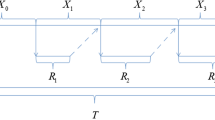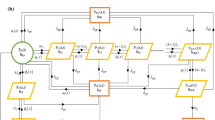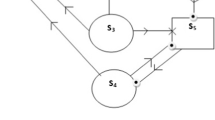Abstract
We analyse the survival time of Birolini’s duplex system sustained by a cold standby unit subjected to a priority rule. We employ a stochastic process endowed with time-dependent transition measures satisfying coupled partial differential equations leading to the Laplace transform of the survival function. As an example, we consider Coxian distributions for failure and repair. Some graphs are displayed together with a security interval corresponding to a security level of 90 %.











Similar content being viewed by others
References
Amari SV, Pham H (2010) A new insight into a \(k\)-out-of-\(n\) warm standby model. Int J Perform Eng 6(6):615–617
Anisimov V, Sztrik J (1969) Asymptotic analysis of some complex renewable systems in random environments. Eur J Oper Res 41:162–168
Apostol TM (1978) Mathematical analysis. Addison-Wesley, London
Birolini A (2007) Reliability engineering. Theory and practice. Springer, Berlin. doi:10.1007/978-3-540-49390-7
Brémaud P (1991) Point processes and queues. In: Springer series in statistics. Springer, Berlin
Cao J (1987) Availability and failure frequency of a multi-unit parallel system. Asia-Pac J Oper Res 4:83–90
Cox DR (1955) A use of complex probabilities in the theory of stochastic processes. Math Proc Camb Philos Soc 51:313–319. doi:10.1017/80305004100030231
Dhillon BS, Yang N (1969) Availability analysis of a robot with safety system. Microelectronics and Reliability 36(2):169–177
Doob JL (1994) Measure theory. Springer, Berlin
Epstein B, Weissmann I (2008) Mathematical models for system reliability. Chapman and Hall & CRC Press, Baton Rouge
Gakhov LD (1996) Boundary value problems. Pergamon Press, Oxford
Gaver DP (1963) Time to failure and availability of paralleled systems with repair. IEEE Trans Reliab 12:30–38
Gnedenko BV, Ushakov IA (1995) Probabilistic reliability engineering. In: Falk J (ed). Wiley, New York
Kim DS, Lee SM, Jung J-H, Kim TH, Lee S, Park JS (2012) Reliability and availability analysis for an on board computer in a satellite system using standby redundancy and rejuvenation. J Mech Sci Technol 26(7):2059–2063
Leung KNF, Zhang YL, Lai KK (2010) A bivariate optimal replacement policy for a cold standby repairable system with repair priority. Naval Res Logist 57:149–158
Leung KNF, Zhang YL, Lai KK (2011) Analysis for a two-dissimilar-component cold standby system with priority. Reliab Eng Syst Saf 96:314–321
Ohashi M, Nishida T (1980) A two-unit paralleled system with general distributions. J Oper Res Soc Jpn 23(4):313–325
Ozaki H, Kara A, Cheng Z (2012) User-perceived reliability of unrepairable shared protection systems with functionally identical units. Int J Syst Sci 45(5):869–883
Roos BW (1996) Analytic functions and distributions in physics and engineering. Wiley, New York
Ruiz-Castro J, Fernández-Villodre G (2012) A complex discrete warm standby system with loss of units. Eur J Oper Res 219:456–469
Ruiz-Castro JE, Pérez-Ocón R, Fernández-Villodre G (2008) Modelling a reliability system by discrete phase-type distributions. Reliab Eng Syst Saf 93:1650–1657
Shaked M, Shanthikumar JG (1990) Reliability and maintainability. In: Heyman DP, Sobel MJ (eds) Handbook in operations research and management science, vol 2. Elsevier Science Publishers, Amsterdam.
Shao J, Lamberson LR (1988) Impact of BIT design parameters on systems RAM. Reliab Eng Syst Saf 23:219–246
Shi DH, Liu L (1996) Availability analysis of a two-unit series system with a priority shut-off rule. Naval Res Logist 43:1009–1024
Shingarewa L, Lizarraga-Celaya C (2009) Maple and mathematica: a problem solving approach for Mathematics. Springer, Berlin
Ushakov IA (2012) Stochastic reliability models. Wiley, New York
Vanderperre EJ (1998) On the reliability of Gaver’s parallel system sustained by a cold standby unit and attended by two repairmen. J Oper Res Soc Jpn 41:171–180
Vanderperre EJ (2000) Long-run availability of a two-unit standby system subjected to a priority rule. Bull Belg Math Soc Simon Stevin 7:355–364
Vanderperre EJ, Yadavalli VSS, Makhanov SS (2004) On Gaver’s parallel system. S Afr J Ind Eng 13(2):141–147
Vanderperre EJ (2008) Long-run availability of a warm standby system. Math Notes 84(5): 623–630. (Published in Russian. Matematicheskie Zametki 84(5):657–667)
Vanderperre EJ, Makhanov SS (2012) Risk analysis of a robot-safety device system subjected to a priority rule. Probab Eng Inf Sci 26:295–306
Vanderperre EJ, Makhanov SS (2013a) Reliability analysis of a repairable duplex system. Int J Syst Sci. doi:10.1080/00207721.2012.759671
Vanderperre EJ, Makhanov SS (2013) Overall availability and risk analysis of a general robot-safety device system. Int J Syst Sci. doi:10.1080/00207721.2013.837592
Vanderperre EJ, Makhanov SS (2013c) On the availability of a warm standby system: a numerical approach. J Span Soc Stat Oper Res. doi:10.1007/s11750-013-0285-9
Vanderperre EJ, Makhanov SS (2013d) Availability analysis of a repairable duplex system : a \(z\)-dependent Sokhotski–Plemelj problem. J Span Soc Stat Oper Res. doi:10.1007/s11750-013-0307-7
Wang HX, Xu GQ (2012) A cold system with two different components and a single vacation of the repairman. Appl Math Comput 219:2614–2657
Wu Q (2012) Reliability analysis of a cold standby system attacked by shocks. Appl Math Comput 218:11654–11673
Yun WY, Cha JH (2010) Optimal design for a general warm standby system. Reliab Eng Syst Saf 95(8):880–886
Acknowledgments
This research is supported by the Center of Excellence in Biomedical Engineering of Thammasat University, Thailand.
Author information
Authors and Affiliations
Corresponding author
Appendices
Appendix A
For direct reference, we propose to state some particular properties of sectionally holomorphic functions and their ramifications for the solution of some boundary value problems on the real line. See Gakhov (1996, pp. 1–40), Roos (1996, pp. 118–242) for proofs and details. Let \(\varphi (\tau )\) be a function satisfying the Hölder (Lipschitz) condition on R and at infinity. In addition, let
We have
Hence, for \(u\in \mathbf {R}\)
The relations (9.1)–(9.4) are called the Sokhotski–Plemelj formulas on the real line. The functions \(\mathcal {L}^+(u),\,\mathcal {L}^{-}(u)\) are continuous on R and infinity. The function \(\varphi (\tau )\) has a unique decomposition and the resulting boundary value Eq. (9.3) has a unique regular solution
valid for all \(\omega \in \mathbf {C}\) and the Cauchy-type integral generates a regular sectionally holomorphic function in C cut along the real line. Furthermore,
Appendix B
To present a comprehensive derivation of the Eqs. (5.1)–(5.5), we first proceed to the Laplace transformation of Eq. (4.7). i.e.
Applying the product rule (partial integration) yields
Note that the initial condition \(N_0=A, x_0=f\) implies that
Hence,
Next, we transform Eq. (10.1). Changing the order of integration, justified by the Tonelli–Hobson test, e.g. Apostol (1978, page 415) and applying the product rule again, taking the property \(p_A(\cdot ,\infty )=0\) into account, entails that
Finally, note that the definition and properties of the \(\mathbf {E}\) operator imply that
The Eqs. (5.2–5.5) are obtained in a similar way. For instance, observe that
independent of the order of integration.
Rights and permissions
About this article
Cite this article
Vanderperre, E.J., Makhanov, S.S. Reliability of Birolini’s duplex system sustained by a cold standby unit and subjected to a priority rule. TOP 23, 441–465 (2015). https://doi.org/10.1007/s11750-014-0348-6
Received:
Accepted:
Published:
Issue Date:
DOI: https://doi.org/10.1007/s11750-014-0348-6
Keywords
- Duplex system
- Priority rule
- Survival function
- Stopping time
- Security interval
- Sectionally holomorphic function
- Coxian distribution




